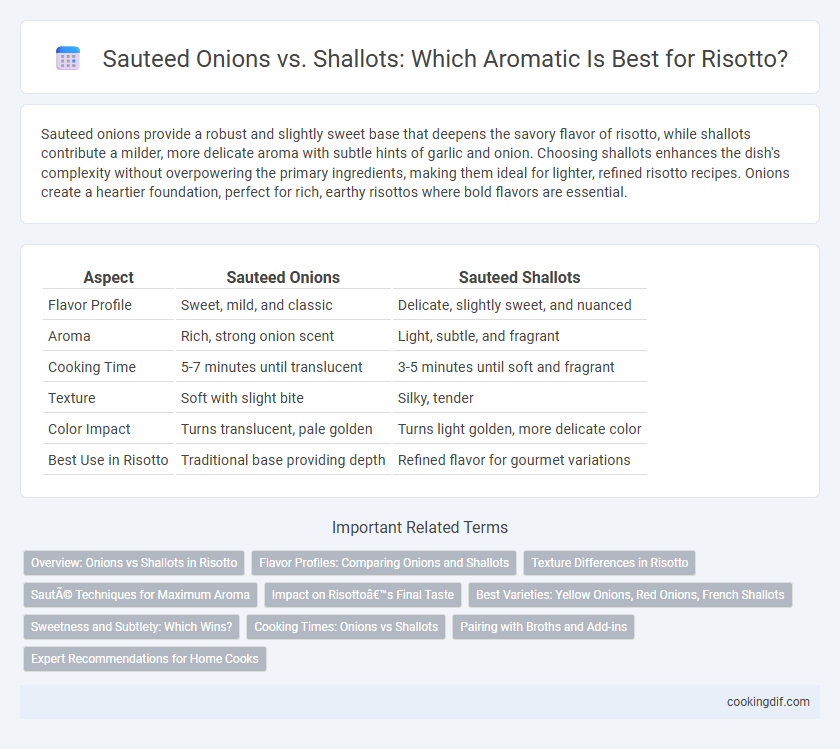Sauteed onions provide a robust and slightly sweet base that deepens the savory flavor of risotto, while shallots contribute a milder, more delicate aroma with subtle hints of garlic and onion. Choosing shallots enhances the dish's complexity without overpowering the primary ingredients, making them ideal for lighter, refined risotto recipes. Onions create a heartier foundation, perfect for rich, earthy risottos where bold flavors are essential.
Table of Comparison
| Aspect | Sauteed Onions | Sauteed Shallots |
|---|---|---|
| Flavor Profile | Sweet, mild, and classic | Delicate, slightly sweet, and nuanced |
| Aroma | Rich, strong onion scent | Light, subtle, and fragrant |
| Cooking Time | 5-7 minutes until translucent | 3-5 minutes until soft and fragrant |
| Texture | Soft with slight bite | Silky, tender |
| Color Impact | Turns translucent, pale golden | Turns light golden, more delicate color |
| Best Use in Risotto | Traditional base providing depth | Refined flavor for gourmet variations |
Overview: Onions vs Shallots in Risotto
Sauteed onions in risotto provide a robust, sweet flavor that deepens as they caramelize, enhancing the dish's savory profile. Shallots offer a milder, more delicate aroma with subtle hints of garlic, creating a refined and balanced base for risotto. Choosing between onions and shallots depends on the desired intensity and complexity of flavors, influencing the overall taste experience.
Flavor Profiles: Comparing Onions and Shallots
Sauteed onions provide a robust and sweet flavor that deepens the savory base of risotto, while shallots offer a milder, more delicate taste with subtle hints of garlic and a slight sweetness. The choice between onions and shallots influences the aroma and complexity, with onions delivering a heartier foundation and shallots enhancing nuanced, refined layers. Using shallots can result in a smoother, less pungent aromatic profile, ideal for risottos emphasizing delicacy and balance.
Texture Differences in Risotto
Sauteed onions provide a slightly firmer texture and a more robust bite in risotto, contributing to a heartier mouthfeel. Shallots, on the other hand, soften more quickly and impart a delicate, velvety consistency that blends seamlessly into the creamy base. Choosing shallots enhances the smooth, luxurious texture, while onions add noticeable layers of texture contrast.
Sauté Techniques for Maximum Aroma
Sauteing onions and shallots releases distinct aromatic profiles essential for a flavorful risotto; onions provide a robust, sweet base, while shallots offer a delicate, nuanced sweetness. To maximize aroma, finely dice shallots for quicker caramelization and cook over medium heat, stirring frequently to avoid burning and ensure even browning. In contrast, onions benefit from a slightly longer saute on moderate heat to develop deep, savory notes that enhance the risotto's complexity.
Impact on Risotto’s Final Taste
Sauteed onions introduce a robust, slightly sweet flavor that deepens the savory profile of risotto, while shallots offer a more delicate, nuanced aroma with subtle sweetness and mild sharpness, enhancing the dish's complexity. The choice between onions and shallots significantly influences the risotto's final taste, where onions provide heartier depth and shallots contribute a refined, elegant character. Mastering this selection allows chefs to tailor the risotto's flavor balance, achieving either a bold, comforting richness or a light, sophisticated aroma.
Best Varieties: Yellow Onions, Red Onions, French Shallots
Yellow onions deliver a robust, sweet flavor that deepens the risotto's aroma and richness, making them a favorite for sauteing. Red onions add a mild, slightly fruity note and vibrant color, enhancing both taste and presentation. French shallots offer a delicate, subtle sweetness with a hint of garlic, providing a refined aromatic complexity ideal for elegant risotto dishes.
Sweetness and Subtlety: Which Wins?
Shallots offer a sweeter and more delicate flavor compared to onions, enhancing risotto's aromatic profile without overpowering other ingredients. Their subtlety allows the natural creaminess of arborio rice to shine while providing a nuanced depth that sauteed onions can sometimes mask with their stronger, more pungent taste. Choosing shallots over onions elevates the risotto's balance, making it a preferred aromatic for chefs seeking a refined sweetness and gentle complexity.
Cooking Times: Onions vs Shallots
Sauteed onions require a longer cooking time, typically 5 to 7 minutes, to achieve a soft, caramelized texture that enhances risotto's depth of flavor. Shallots cook more quickly, often in 2 to 3 minutes, offering a delicate, slightly sweeter aroma that infuses the dish without overpowering other ingredients. Choosing between onions and shallots depends on the desired balance of flavor and cooking time in risotto preparation.
Pairing with Broths and Add-ins
Sauteed onions provide a robust, slightly sweet base that pairs well with hearty broths like beef or mushroom, enhancing the risotto's umami depth. Shallots offer a milder, more delicate sweetness that complements lighter broths such as chicken or vegetable, allowing subtle add-ins like herbs and seafood to shine. Choosing between onions and shallots depends on the desired flavor intensity and the specific broth and add-ins used in the risotto recipe.
Expert Recommendations for Home Cooks
Home cooks aiming for authentic risotto flavor typically prefer shallots over sauteed onions due to their subtle sweetness and delicate texture, which enhance the dish's aromatic base without overpowering it. Culinary experts emphasize that finely minced shallots integrate more evenly into the rice, promoting a balanced and nuanced flavor profile essential for traditional risotto. Using shallots supports the slow, gentle cooking process critical to achieving the creamy consistency and complex taste prized by risotto aficionados.
Sautéed onions vs shallots for aromatics Infographic

 cookingdif.com
cookingdif.com